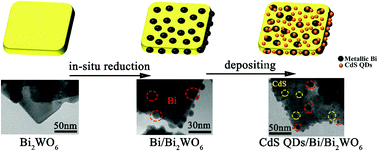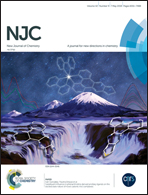Structure of flower-like hierarchical CdS QDs/Bi/Bi2WO6 heterojunction with enhanced photocatalytic activity
Abstract
A flower-like hierarchical CdS QDs/Bi/Bi2WO6 heterojunction photocatalyst was synthesized via an in situ reduction and deposition process. The samples were systematically characterized via X-ray diffraction (XRD), scanning electron microscopy (SEM), transmission electron microscopy (TEM), high resolution TEM (HRTEM), X-ray photoelectron spectroscopy (XPS), energy dispersive spectroscopy (EDS), UV-vis diffuse reflectance spectroscopy (UV-vis DRS), nitrogen absorption–desorption isotherms, photoelectrochemical measurements and photoluminescence spectroscopy (PL). The results indicate that plasmonic Bi nanoparticles as the electron-conduction mediator with size of 10 nm promote charge transfer effectively between the CdS nanoparticles and Bi2WO6 nanosheets. The photocatalytic performance tests show that the CdS QDs/Bi/Bi2WO6 composite exhibits extraordinarily enhanced photocatalytic activity than pure Bi2WO6, Bi/Bi2WO6 and CdS QDs/Bi2WO6 for the photodegradation of Rhodamine B and formaldehyde. The superior photocatalytic performance of the CdS QDs/Bi/Bi2WO6 composite is attributed to its improved visible light absorption property by coupling CdS QDs with plasmonic Bi and also to the efficient charge transfer of the metallic Bi nanoparticles.



 Please wait while we load your content...
Please wait while we load your content...